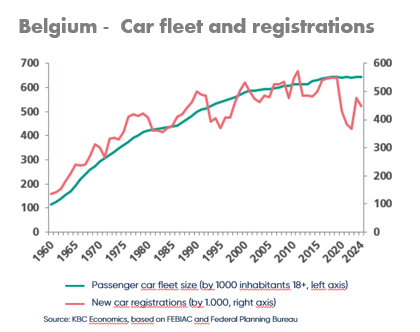
Mobility Week: Demographic and societal trends driving new mobility
Rising prosperity leads to sharp rise in demand for mobility. This was evident in the past from the rise of the automobile, for example. The strong economic growth of the 1950s and 1960s delivered the first major leap in prosperity, which in turn prompted a huge increase in demand for cars. This was compounded by the increasing participation of women in the labour market. Our society consequently evolved towards the two-earner model and, in many cases, consequently towards the two-car household model.
Highway mobility
The fact that there are so many cars on the roads in Belgium is obviously also due to the dense road network. Or perhaps it’s the other way around: the number of cars on the roads necessitate an extensive road infrastructure. As the backbone of sustained economic expansion, major efforts were made to create that infrastructure at the start of the second half of the last century. For example, the E5 and E3 motorways, today designated as the E40 and E17, respectively, formed the east-west and north-south axes. The main intention was to create lucrative industrial axes, but the roads also provided a strong boost to overall mobility. For example, there was suddenly a highway heading towards the coast; this led to an unprecedented increase in passenger traffic, from 130 billion kilometres travelled in 1990 to more than 170 billion kilometres today.
Applying the brakes
By now, the limits to that growth have become clear to all of us. The road network is clogging up more frequently, for longer and in more and more places, with significant costs to the economy. Economists estimate that at more than 1% of GDP (more than 5 billion euros lost in downtime, or 400 euros per person per year - lost hours, extra fuel, extra emissions, etc.). People are increasingly aware of this. In Belgium, we already appear to be approaching the saturation point of car ownership; the car market is stagnant, and car sales are largely driven by replacement demand. Today, people are increasingly delaying that replacement. The market is gripped by uncertainty regarding electric vehicles, causing orders to be delayed and the average age of a car to exceed ten years for the first time. This is delaying our progress towards greener mobility.

On the road towards a different kind of mobility
In addition, societal, technological and other changes are leading to a less car-dependent lifestyle. Young adults today view car use and ownership completely differently from the generation before them, especially when it comes to sustainability. A Deloitte survey in Belgium, for example, showex that a third of respondents question the value of car ownership, and one in five are interested in car-sharing. That concept could offer a solution, especially in a metropolitan urban setting.
Six wheels
But bicycles - not infrequently offered through an employer bicycle leasing plan - are also a fully-fledged alternative to the car for lots of young people. On the other hand, once those young adults start a family and trade living in the city centre for the suburbs or the countryside, the family car comes back into the picture. But this will be complemented by a cargo or longtail bike, rather than a second car.

KBC Autolease was in at the inception of the bike leasing story in Belgium, and today has more than 33 000 bikes on the road. And the market is still growing, thanks to favourable tax treatment, but also to the new approach to mobility. It’s evident in the growing network of bicycle parking facilities at companies, including loading space and facilities for sports enthusiasts.

Non-urgent travel
Those sports enthusiasts actually account for a surprisingly high proportion of total travel. 60% of all journeys are completed in our leisure time, mainly for shopping, sports and hobbies. And recreational traffic is likely to grow further: think of the increasing number of older people enjoying their ‘golden years’, and the increasing number of single people who are not tied to school holidays.
We all need to work together to deal with the new reality of flexible mobility solutions. We choose which mode of transport to use, and when; smart mobility concepts and services can offer a solution to this. KBC Mobile already offers solutions for train and bus travel, as well as parking for private individuals. This has now been extended to include the self-employed and small businesses.
Employees are also part of the decision on where they work and how they travel to their workplace. Working from home plays an important role in their choice: is there an argument for car-sharing, or is bike-sharing a more preferable option? Or perhaps public transport might offer the best solution? It sounded like pure science fiction barely ten years ago, but today it is already a daily reality for many young people. And that will not change now that the government is seeking to breathe new life into the mobility budget.

The ‘car is king’ - but now has company
The car will continue to be the dominant mode of transport, simply because it is often the only genuinely workable solution. Nonetheless, the notion of multi-mobility is currently top-of-mind, across generations. KBC Autolease is playing an important role in this, and KBC Mobile clearly points the way to the future.
Listen again to the podcast by Wannes Vermost (CEO of KBC Autolease) and Hans Dewachter (Chief Economist at KBC)
KBC Autolease, KBC Economics